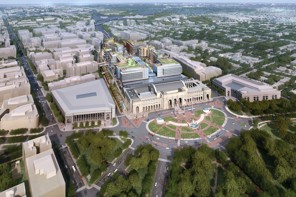By Jonathan O’Connell, August 2, 2012, The Washington Post, Capitol Business
Union Station has played a role in more than a couple of Washington’s most storied moments, from FDR welcoming the future Queen Elizabeth II there in 1939 to the Beatles’ arrival in 1964 to play their first show in North America.
Now preservationists are beginning to weigh in on Amtrak’s $7 billion master plan for the station, which could triple passenger capacity there over the next 20 years.
The last major push to improve the station, in the 1980s, led Congress to create the Union Station Redevelopment Corp., and ultimately resulted in a $160 million public-private partnership that restored the main hall so it could be re-opened to the public in 1988.
A week after Amtrak released its newest plan, a collection of neighborhood and historical preservation groups have formed the Union Station Preservation Coalition to guide the newly proposed changes. Four groups have joined on: the Capitol Hill Restoration Society, the Committee of 100 on the Federal City, the D.C. Preservation League and the National Trust for Historic Preservation.
The group plans to release a 12-page briefing on the project, available here.
The initial response from preservations: We need more information.
A rendering of proposed development at Union Station showing a view of the concourse and platform area that Amtrak has proposed building behind the existing Union Station building, with wide hallways and connections that the agency said would reduce congestion and improve connections for passengers within the station. (Courtesy of Amtrak)“We’re cautiously optimistic about what we saw,” said Rob Nieweg, director of the Washington field office at the National Trust. He said the difficulty with adding $7 billion worth of new train tracks and courses — as well as the $1.5 billion Burnham Place project above the tracks by developer Akridge — is that those two massive pieces of construction must be integrated with the original 1907 building in a functional and cohesive way.
“The primary concern of what’s been shared with the public is the lack of information about how the new train shed, by Amtrak, or the Burnham Place project, would be politically integrated with the head house — Union Station as we know it,” he said.
The briefing includes eight recommendations toward careful stewardship of the original building, including emphases on public participation, restoration of original pedestrian patterns and an exceptional experience for visitors.
Nieweg said he is trying to arrange a briefing with Amtrak and Akridge officials to learn more. Despite some concerns, he said all the parties share common goals.
“The clear intention of Amtrak and of Akridge is to bring new life to that area and a preservation’s first thought is keeping a place like this vital into the next generation,” he said.

